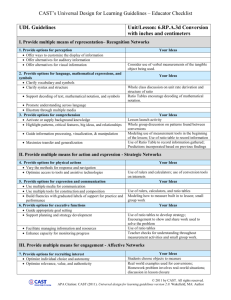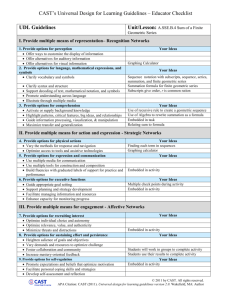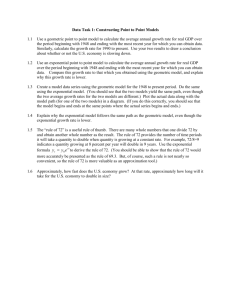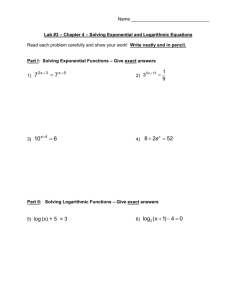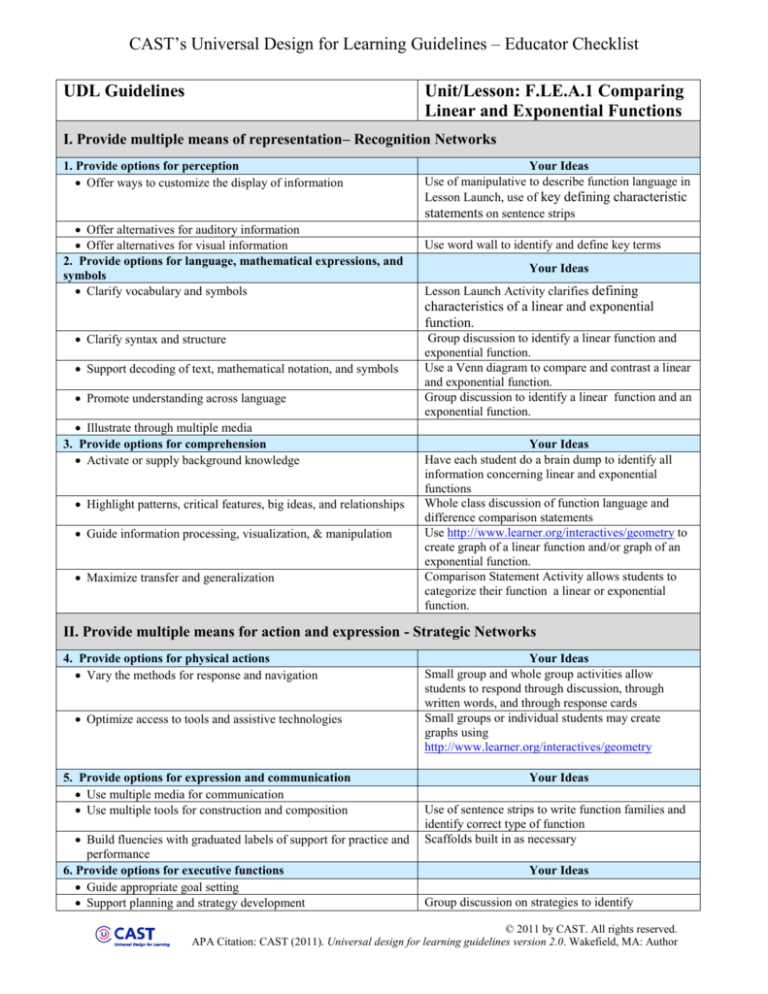
CAST’s Universal Design for Learning Guidelines – Educator Checklist
UDL Guidelines
Unit/Lesson: F.LE.A.1 Comparing
Linear and Exponential Functions
I. Provide multiple means of representation– Recognition Networks
1. Provide options for perception
Offer ways to customize the display of information
Offer alternatives for auditory information
Offer alternatives for visual information
2. Provide options for language, mathematical expressions, and
symbols
Clarify vocabulary and symbols
Your Ideas
Use of manipulative to describe function language in
Lesson Launch, use of key defining characteristic
statements on sentence strips
Use word wall to identify and define key terms
Your Ideas
Lesson Launch Activity clarifies defining
characteristics of a linear and exponential
function.
Clarify syntax and structure
Support decoding of text, mathematical notation, and symbols
Promote understanding across language
Illustrate through multiple media
3. Provide options for comprehension
Activate or supply background knowledge
Highlight patterns, critical features, big ideas, and relationships
Guide information processing, visualization, & manipulation
Maximize transfer and generalization
Group discussion to identify a linear function and
exponential function.
Use a Venn diagram to compare and contrast a linear
and exponential function.
Group discussion to identify a linear function and an
exponential function.
Your Ideas
Have each student do a brain dump to identify all
information concerning linear and exponential
functions
Whole class discussion of function language and
difference comparison statements
Use http://www.learner.org/interactives/geometry to
create graph of a linear function and/or graph of an
exponential function.
Comparison Statement Activity allows students to
categorize their function a linear or exponential
function.
II. Provide multiple means for action and expression - Strategic Networks
4. Provide options for physical actions
Vary the methods for response and navigation
Optimize access to tools and assistive technologies
5. Provide options for expression and communication
Use multiple media for communication
Use multiple tools for construction and composition
Build fluencies with graduated labels of support for practice and
performance
6. Provide options for executive functions
Guide appropriate goal setting
Support planning and strategy development
Your Ideas
Small group and whole group activities allow
students to respond through discussion, through
written words, and through response cards
Small groups or individual students may create
graphs using
http://www.learner.org/interactives/geometry
Your Ideas
Use of sentence strips to write function families and
identify correct type of function
Scaffolds built in as necessary
Your Ideas
Group discussion on strategies to identify
© 2011 by CAST. All rights reserved.
APA Citation: CAST (2011). Universal design for learning guidelines version 2.0. Wakefield, MA: Author
CAST’s Universal Design for Learning Guidelines – Educator Checklist
proportional function and non proportional function
Facilitate managing information and resources
Enhance capacity for monitoring progress
Function Type Response Cards to monitor progress
throughout the lesson.
III. Provide multiple means for engagement - Affective Networks
7. Provide options for recruiting interest
Optimize individual choice and autonomy
Optimize relevance, value, and authenticity
Minimize threats and distractions
8. Provide options for sustaining effort and persistence
Heighten salience of goals and objectives
Vary demands and resources to optimize challenge
Foster collaboration and community
Increase mastery-oriented feedback
9. Provide options for self-regulation
Your Ideas
Reflection Closure encourages individual opinions
and thoughts. Have students identify and reflect on
one of the math practices.
Identify functions that are relevant to age group.
Your Ideas
Whole group discussion, closure, Think – Pair Share
Opportunities to work in small groups and groups
that are fluid
Whole group discussion, reflection in closure,
individual exit tickets that are reflections on the
lesson’s uplifted practice(s)
Your Ideas
Promote expectations and beliefs that optimize motivation
Use Glogster http://www.glogster.com/ to create
an online poster for the identified function.
Facilitate personal coping skills and strategies
Develop self-assessment and reflection
Use of lesson’s progression diagram
Use of 3-2-1 student reflection in closure
Howard County Public Schools Office of Secondary Mathematics Curricular Projects has licensed this
product under a Creative Commons Attribution-NonCommercial-NoDerivs 3.0 Unported License.
© 2011 by CAST. All rights reserved.
APA Citation: CAST (2011). Universal design for learning guidelines version 2.0. Wakefield, MA: Author

